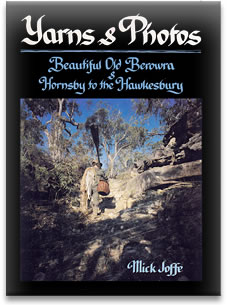 Yarns & Photos
We have found in storage the last few boxes of the original 1992 print. This book has not been re-released. These won't last long!
$149 + Postage
Buy Now
Yarns & Photos
We have found in storage the last few boxes of the original 1992 print. This book has not been re-released. These won't last long!
$149 + Postage
Buy Now
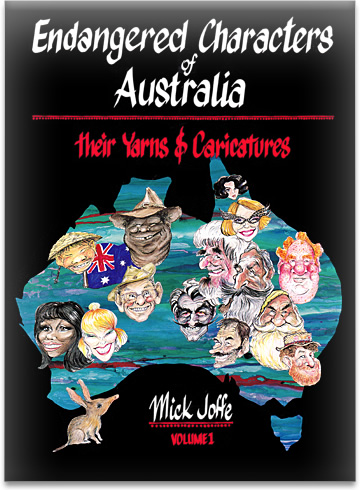 Endandgered Characters of Australia
We have found in storage the last few boxes of the original 1995 print. This book has not been re-released. These won't last long!
$149 + Postage
Buy Now
Endandgered Characters of Australia
We have found in storage the last few boxes of the original 1995 print. This book has not been re-released. These won't last long!
$149 + Postage
Buy Now
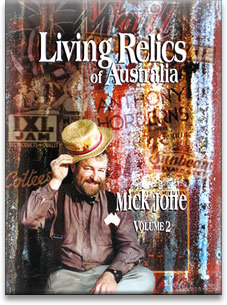 Living Relics of Australia
Living relics contains 25 of our greatest living characters. This coffee table hard-cover book combines the very Australian art of caricature with oral history - the history of drovers, shearers, naturalists, miners, artists, explorers, etc. Their caricature captures them on the outside and their own words capture them on the inside.
Only $29 + Postage
Buy Now
Living Relics of Australia
Living relics contains 25 of our greatest living characters. This coffee table hard-cover book combines the very Australian art of caricature with oral history - the history of drovers, shearers, naturalists, miners, artists, explorers, etc. Their caricature captures them on the outside and their own words capture them on the inside.
Only $29 + Postage
Buy Now
Interviewed: 2000
Published online: Wednesday, 15 September 2010
This interview is from Endangered Characters of Australia.
Fred Costello
Born 1904
Speared by Aborigines
My grandparents were gold miners in Bendigo. Dad, John Costello, was a gaol warder. I was about thirteen and a half when I ran away from home and school, workin’ for cockies for food and a bed to lay in. I first came to the Territory with horses in 1926 from Western Queensland. I worked on a station as a ringer. As a prospector I got a couple of leads around Halls Creek. I had 6 or 7 camels on my camel string. When you went out prospecting it might be 6 months, so you carried flour, tea and sugar.
I used camels for knocking around, prospecting, a bit of dogging. Scalps were 7 shillings and 6 pence a scalp then. In 1928, about 5 miles away from Anabella Spring, Tietkens Birthday Creek, the Aborigines came up to my camp in the night and stole all me tucker. They pinched the sugar, flour, tobacco. I was asleep. I woke up and saw their tracks around the tucker boxes. I got another blackfella and followed their tracks up into the ranges, like a fool. I went in this cave about the size of this room and seen all me tucker thrown about. I got the blackfella to pick it up and went out the front of the cave and was standing with me back to the cave, holding a revolver, looking about for them. The Aborigines came over the top of the cave and that’s when they speared me in the back, right on me backbone. Between the shoulder blades it was. It wasn’t a shovelnose; it was a mulga barb spear. Stuck in and hurt like hell. I fired the revolver back over my head. I staggered down the hill and somehow got on me camel and rode about 2 miles back to camp. An old fella, Tom Grady, by pure luck came along on the same day, about 2 hours later. He was doggin’, same as me. I reckon he saved me. I would have been finished. I was paralysed in the upper body. I was pretty helpless. When I got cold, I got stiff. It wasn’t a bloody wound but it was in a bad place. I remember the pain; it was in the sinew. He give me a bit of a hot poultice. Old Tom stayed with me and I camped there about a week. Just healed up myself; too far away to go to the doctors. I’ve never bothered showin’ it to a doctor. I’ve never recounted that story before. I shot one bloke in the neck; didn’t kill him, though, and they took him to the hills then.
I can’t recall any other whitefellas that had the same experience as me [lived through a spearing] ‘cause the blackfella usually made a job of it. Without my revolver I would have been absolutely defenceless. That was their country and they were like bloody kangaroos in their country. They’d tie 3 kangaroos and balance them on top of their heads, then go down the side of a mountain. Those mountain blacks in that granite mountain country were that agile, they were like mountain wallabies. The Pitjantjatjara were right through that country - Peterman, Musgrave and Mann Ranges.
That Coniston clean-up, they shot over 300. Officially it was only 30. They shot far more blacks than blacks killed whites. The ratio would be 20 to 1 or more. I don’t think I would have been in it. I don’t believe in shooting human beings like rabbits. The irony of it all, the blackfellas that killed Fred Brooks, they shot through to Mt Hardy about 100 miles from the Coniston and the police arrested them 6 months later, took ‘em to Darwin, tried ‘em and they got acquitted which makes the whole clean-up a joke. Us old-timers didn’t refer to it as a massacre; we called it a shoot-out or a clean-up. The only other one I knew of was in 1924 over in the Kimberley - 2 policemen got the sack over that. You can bet your life the official number wasn’t the right number. I was over at the Cooper when that happened, working on a cattle station there. I worked on Coniston for about 2 years straight after. A blackfella showed me all the bones from the massacre. Some were scattered; some were in a heap. I only saw about a dozen skeletons. Any gins and kids we saw were terrified.
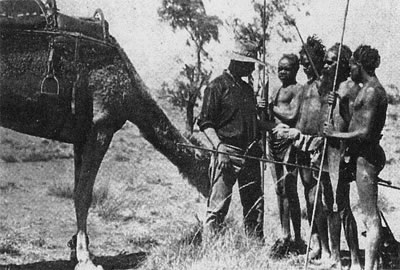 Bob Buck questions the Natives
Bob Buck questions the Natives
I always had a lot of respect for Aborigines. No, I never hated the blackfella. I always reckoned it was their country. We were intruders. Aborigines were conned out of their own country; shot if they wouldn’t go peacefully. All the white man had to do was make a mark to mark his area out on a map and it was his lawfully. They paid a nominal amount, like a pound a square mile. I mean to say, they’ve lived here 40,000 years or longer. All this business about Aborigines... They had a terrible deal. The half-castes, if they stopped in the camps, were often not recognised; and the Aborigines were not given a fair go. In a court case the blackfella was always wrong.
The Afghans were very prominent around Birdsville, Maree, Oodnadatta, Alice Springs and Broken Hill. Big camp at Broken Hill. Gool Mahomet Sadadeen. They were good people, the Afghans. I got on well with them. If you came to their camp, meal time, they always asked you to eat with them. They were very clean fellas, the Afghans. They eat with their left hand and wipe their behind with their right hand. I learned a lot about handling camels from them. They used to load pianos atop camels; railway sleepers, galvanised iron, any bloody thing! They used to make good money, carting stores. I found them honest. They were treated like Aborigines themselves. In Maree an old policeman, Tim Lelly, used to ride his horse around town and chase all the blackfellas back to their camp and he used to chase the Afghans too.
I get on well with Chinamen too. They’re friendly people, honest people. If you fell out with a Chinaman, you fell out with the lot of ‘em. They stick together. On cattle stations, if you had a Chinese cook and a Chinese gardener, you lived well. The old Chinaman, he’s got a lot of dry humour. You couldn’t get a more hardworking people.
Aw, there’s still a few old fellas like me kickin’ about but there’s not enough history written about Australia. The Aborigines, they got a terrible bloody spin. They shot ‘em out, chased ‘em out. As stockmen, you couldn’t beat ‘em. They’d have never run their stations without them. Good horsemen; knew every horse in the place and they knew every corner of the property and in the struggling years, worked virtually for nothing - bit of tucker and tobacco. That’s all. In the Peterman and Musgrave Ranges I’ve seen the Aborigines all in their tribal state. They all were until well after the second world war when they rounded them all up out of the way of the rocket testing. From Maralinga right through to Broome. All those desert people, they had very little contact with white people before the rockets started. The Aborigines I mixed with in the Peterman and Musgrave Ranges didn’t speak any English. They were naked or wore cockrags. Some of them might have met white people before me but there was no way of knowing. They only spoke their own language. See, the blackfella had a set of laws and the white fella came along and didn’t understand ‘em and came along and broke ‘em.
I was a government dogger for a while in Halls Creek. I knew an old bloke called Tom Brady, used to put a bit of strychnine on the end of his penknife and wash it down with a drink of tea. He was a first war vet. and had some war complaint. Used to shake like a leaf, but the strychnine stopped it. I know when I was changing strychnine from one bottle to another and a bit of wind blew a tiny bit towards me face, I’d get a terrible headache straight away. Monty Sullivan and a couple of his mates at Katherine, the cork came out of the strychnine or the bottle broke in their packbag and it all got mixed up with their flour and a couple of ‘em died. It doesn’t take much to kill a man with strychnine. They killed a lot of blackfellas with it. Poured it in their flour or sugar or tea. Done to clear cattle country of blacks. For every white man killed, there might be 100 blacks killed. They put the smallpox among ‘em too.
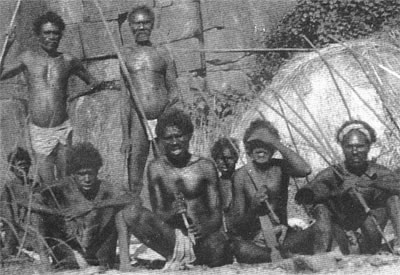
Dr Madigan’s crossing of the Simpson Desert with camels was in the 1930s, but it was definitely not the first crossing with camels; it was just the one with the publicity. A lot of cattlemen worked around the fringes of it. That was all hooey about Madigan and Colston. I was in that country about that time, knocking around that range country with camels. I had been around the edge of it with camels but not across it. Stockmen had been across that country before, chasing cattle and pinchin’ cattle and getting away with it. They shot blackfellas out near Tanami, over 300 they reckon. It was about 1928. Compared to other people, the ol’ blackfella was really a harmless bastard.
One of these days Halls Creek is gonna boom again. It was never worked out. Quite a few shows but Halls Creek’s a big field, 100 miles long, easy, and the Chinese never got in there. There’ll be a big find there one day but I’ll be stonkered to push me wheelbarrow.
Aw, a lot of history’s been lost and a lot of bullshit’s been written but what you’re doing’s all right. There should be more of it, Mick. There’s a terrible lot of history lost, especially among the blacks ‘cause they don’t write it down. My brother Frank had a saying, “Those who the gods love die young“; there’s a lot in that. Tom Cole is right - old age is a bastard ... ya just hang on. Some people cut out at 40. When I was about 91 I just got crook, went from 10 stone 5 to 7 stone and I’m still about 7 stone. I think the human race will be like the dinosaurs, some bloody catastrophe will come along and blow it all up.

Fred Costello was recorded in the Red Cross Hostel in Katherine. His history speaks for itself. It’s safe to say he’s the last white man you could meet who’s been speared by wild Aborigines.
Mick Joffe
More Characters
Since the early 1970s, Mick Joffe's passion has been to caricature and record endangered characters of Australia, and the world. As of 2015, the majority of these interviews exist only in manuscript form.
Click here to see the full list of interviews...
 Yarns & Photos
We have found in storage the last few boxes of the original 1992 print. This book has not been re-released. These won't last long!
$149 + Postage
Buy Now
Yarns & Photos
We have found in storage the last few boxes of the original 1992 print. This book has not been re-released. These won't last long!
$149 + Postage
Buy Now
 Endandgered Characters of Australia
We have found in storage the last few boxes of the original 1995 print. This book has not been re-released. These won't last long!
$149 + Postage
Buy Now
Endandgered Characters of Australia
We have found in storage the last few boxes of the original 1995 print. This book has not been re-released. These won't last long!
$149 + Postage
Buy Now
 Living Relics of Australia
Living relics contains 25 of our greatest living characters. This coffee table hard-cover book combines the very Australian art of caricature with oral history - the history of drovers, shearers, naturalists, miners, artists, explorers, etc. Their caricature captures them on the outside and their own words capture them on the inside.
Only $29 + Postage
Buy Now
Living Relics of Australia
Living relics contains 25 of our greatest living characters. This coffee table hard-cover book combines the very Australian art of caricature with oral history - the history of drovers, shearers, naturalists, miners, artists, explorers, etc. Their caricature captures them on the outside and their own words capture them on the inside.
Only $29 + Postage
Buy Now
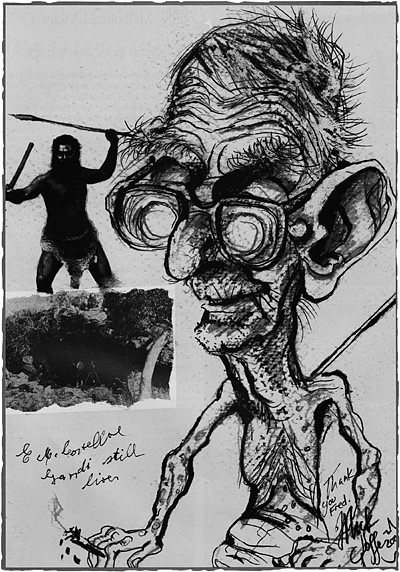 Caricature of Fred Costello, by Mick Joffe
Caricature of Fred Costello, by Mick Joffe
 H.R.H. Prince LeonardPrince of Hutt River Province
H.R.H. Prince LeonardPrince of Hutt River Province Milton Golby
Milton Golby Ken DownesSnowy River Canoeing
Ken DownesSnowy River Canoeing Ted MatthewsThe Last Anzac
Ted MatthewsThe Last Anzac Eric JolliffeFamous cartoonist of the outback
Eric JolliffeFamous cartoonist of the outback Doc HowlettPioneer tuna fisho of Port Lincoln
Doc HowlettPioneer tuna fisho of Port Lincoln